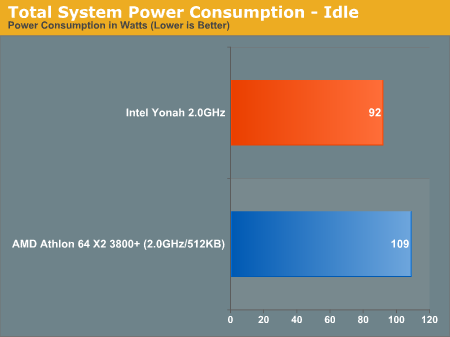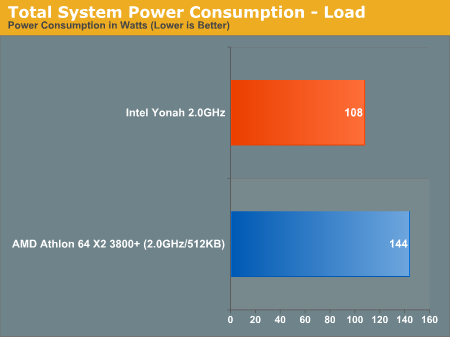Intel Yonah Performance Preview - Part I: The Exclusive First Look at Yonah
by Anand Lal Shimpi on November 30, 2005 2:50 AM EST- Posted in
- CPUs
Power Consumption and Final Words
At 2.0GHz, Yonah is basically equal to, if not slightly slower than an Athlon 64 X2 running at the same clock speed in virtually all of the tests we ran. The important distinction here is that Intel is able to achieve that level of performance, without an on-die memory controller. But there is also one more thing to note, Yonah can offer that level of performance with significantly lower power consumption:


While the Yonah and Athlon 64 X2 systems consumed relatively similar power at idle, Yonah hardly eats up any more power under full load. In fact, a 2.0GHz Yonah under 100% load consumes less power than an Athlon 64 X2 3800+ at idle. Obviously Intel has the advantage of being on a much lower power 65nm process, but it won't be until the second half of next year before we see any Athlon 64 X2s at 65nm, so it is an advantage that Intel will have for quite some time.
Although we didn't consider it as such here today , Yonah will be quite impressive on notebooks. The thought of having such a cool running dual core processor in a notebook is honestly amazing, and the performance difference (especially for multitaskers) over what we have today will be significant. The other thing to keep in mind is that when you go from a single core to a dual core Pentium M notebook, you won't be giving up anything at all. On the desktop side, you normally give up clock speed for dual core support, but Yonah will be running at very similar frequencies to what Dothan is running at today. In other words, you won't be giving up single threaded performance in favor of multi-threaded performance - you'll get the whole package.
As a desktop contender, Yonah is a bit of a mixed bag. While its performance in content creation applications has definitely improved over the single core Dothan, it still falls behind the Athlon 64 X2 in a handful of areas. Intel still needs to improve their video encoding and gaming performance, but it looks like we may have to wait for Conroe and Merom for that.










135 Comments
View All Comments
lee1026 - Wednesday, November 30, 2005 - link
They still can't beat the A64 3800+? sad, intel, sad.Pythias - Wednesday, November 30, 2005 - link
Graphs I looked at, it appeared the two were neck and neck. And the yonah cosumes less power.Darth Farter - Wednesday, November 30, 2005 - link
well, what about the RAM power consumption difference... is this censored or something?Yonah's 1.8V DDR2 ram opposed to the Athlon X2's 2.6V DDR ram
if the reviewer really measured "Total System Power" this will factor in... the same reason why the Pentium M is still king of Battery Life on mobile platforms...
When Socket M2 arrives Q2 2006 it could prove better for performance and less for power requirements again.... and without being transitioned to 65nm process yet.
anyway, this is not cpu isolated and therefore I'd suggest just mentioning it includes the worse DDR power consumption (apples to apples) before the community blames the cpu only like in the comments here.
(btw, if there would be any way to isolate the cpu power usage only without motherboard and ram I would really like to know. (I thought I saw something like that on overclockers.com a few moths back.)
anyway could my point matter on the graphs on last page Anand?
coldpower27 - Wednesday, November 30, 2005 - link
This is the price you pay for having an On Die Memory Controller, Intel can adopt new memory technologies quciker then AMD can as they don't need another revison of a CPU plus a Socket change due to the memory controller, this is the price AMD paid to get the added performance, and reduced power cosumption of having the memory cnotroller on Die and not needing a Northbridge. This is AMD's choice and they have to live with the consequences of this choice.Zebo - Friday, December 2, 2005 - link
Nevermind they did change thier socket.coldpower27 - Sunday, December 11, 2005 - link
I think they wanted to make sure that only the i945M Chipset series is compatible with the Dual Core Yonah and not run the risk of people sticking these into older i915M and the currently available desktop Pentium M boards.This is a move for profit of course, as Intel wants to sell their new i945M chipsets as a Centrino bundle with Yonah.
nserra - Wednesday, November 30, 2005 - link
AMD 64 2.0Ghz at .13 at full load does 68WAMD 64 2.0Ghz at .09 at full load does 43W
AMD 64 2.0Ghz at .65 at full load maybe ~27W
AMD 64 2.0Ghz at .13 at idle does 19W
AMD 64 2.0Ghz at .09 at idle does 13W
AMD 64 2.0Ghz at .65 at idle maybe ~9W
tayhimself - Wednesday, November 30, 2005 - link
90nm 3800x2 is around 68 W. Take out 8 or so for the northbridge. There is no 130nm x2 IIRCnserra - Wednesday, November 30, 2005 - link
Sorry I forgot to mention, its single core amd processors not dual.Viditor - Wednesday, November 30, 2005 - link
Someone who doesn't know the difference between TDP and power usage...